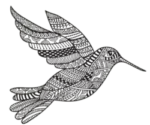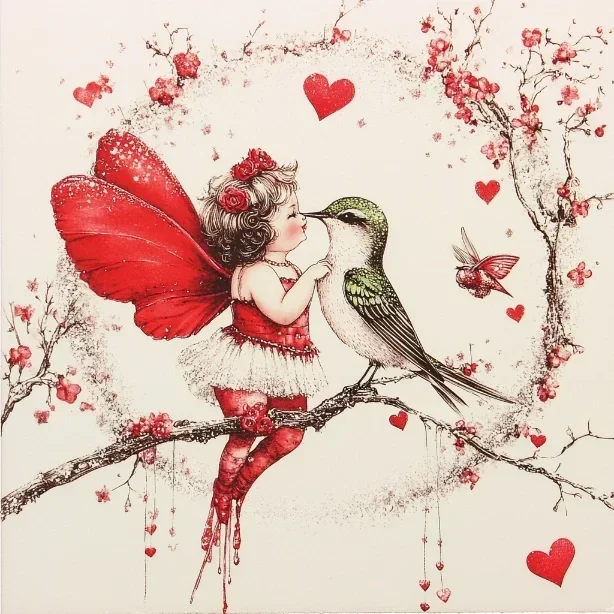(Or: How to Win a Date Using Nature’s Most Dazzling Light Show)
If the animal kingdom had a fashion week, male hummingbirds would be the undisputed supermodels of the avian world. These tiny fashionistas have turned courtship into an art form, combining sophisticated light manipulation, aerial acrobatics, and what can only be described as natural special effects that would make Hollywood jealous.
Let’s start with some courtship credentials that would impress any fashion designer:
- Iridescent feathers that change color with viewing angle
- Specialized light-reflecting structures at the molecular level
- The ability to flash brilliant colors on and off like living disco balls
- Aerial displays that showcase their finest angles
- Courtship dances more complex than most ballet performances
The Science of Spectacular
Imagine owning a coat that changes color every time you move. Now imagine that coat was made of thousands of microscopic prisms, each perfectly aligned to create a light show that would make Las Vegas envious. This is the reality of male hummingbird plumage, where nature has pushed the boundaries of optical physics to create living jewelry.
The Natural Technology Behind the Show:
- Microscopic structures in feathers
- Light-interfering melanosomes
- Specialized barbules that split light
- Iridescent patches strategically placed for maximum impact
- What amounts to nature’s most sophisticated optical engineering
Fashion Shows at 60 Wing Beats per Second
In the world of hummingbird courtship, it’s not enough to simply look good – you have to prove you can work it. Male hummingbirds have turned aerial displays into performance art that would put any runway model to shame, combining death-defying stunts with perfectly timed color flashes.
The Anna’s Hummingbird’s Performance:
- Climbs up to 130 feet in the air
- Plummets toward the ground at spectacular speeds
- Pulls up at the last second with a dramatic chirp
- Flashes brilliant magenta head feathers
- Basically performs a tiny sonic boom with style
The Color-Changing Champions
Not all hummingbirds approach the dating game the same way. Just as human fashion varies across cultures, different hummingbird species have evolved their own unique approaches to catching the eye of potential mates. Some go for subtle elegance, while others seem to have taken inspiration from disco balls.
The Broad-tailed Hummingbird:
- Rose-magenta throat patch
- Flashes colors like a natural strobe light
- Changes hue depending on viewing angle
- Makes sure every female in the vicinity notices
The Ruby-throated Hummingbird:
- Brilliant ruby-red gorget
- Can appear black from certain angles
- Suddenly blazes with color during display
- Masters the art of the surprise color reveal
The Choreography of Courtship
Picture trying to dance the tango while flying a fighter jet and operating a light show simultaneously. That’s essentially what male hummingbirds accomplish during their courtship displays, executing precise aerial maneuvers while ensuring their iridescent feathers catch the light at just the right angle.
The Basic Performance Package Includes:
- Shuttle displays back and forth
- Dive bombs with precision timing
- Synchronized color flashing
- Acoustic accompaniment
- What looks suspiciously like showing off just because they can
The Competition Factor
When multiple male hummingbirds vie for female attention, the result is something akin to a combination of “America’s Got Talent,” the Olympics, and a light show – all performed by contestants weighing less than a nickel. The competition can get fierce, with each male trying to outdo the others in both flash and substance.
The competition includes:
- Territorial displays become more elaborate
- Color flashing intensifies
- Aerial performances reach new heights
- Sound effects get more dramatic
- The tiny equivalent of a fashion runway battle ensues
Nature’s Light Technology
Deep within each iridescent feather lies a marvel of natural engineering that would make a physicist weep with joy. The structural color of hummingbird plumage isn’t just pretty – it’s a testament to the incredible precision of evolution, operating at scales smaller than a wavelength of light.
How They Create the Show:
- Stack of specialized melanin plates
- Air-filled spaces between plates
- Precise spacing for specific wavelengths
- Active control of feather orientation
- What amounts to a living, breathing optical illusion
The Female Perspective
While males put on their spectacular shows, female hummingbirds play the role of nature’s most demanding talent scouts. They’re not just looking for a pretty face (or gorget, in this case) – they’re evaluating everything from flight skills to territory quality, making decisions that would challenge any Olympic judge.
Females evaluate:
- Display quality
- Color intensity
- Flight skill
- Territory quality
- Basically serve as nature’s most demanding talent scouts
The Environmental Challenge
Looking fabulous isn’t easy, especially when you’re a tiny bird battling the elements. Male hummingbirds must maintain their spectacular plumage through rain, wind, and whatever else nature throws at them, all while keeping up their high-energy lifestyle.
Environmental challenges include:
- Requires perfect feather condition
- Demands high-energy investment
- Needs precise preening
- Must be maintained despite weather
- Represents a significant survival challenge
The Evolution of Extravagance
How did these tiny birds develop such extraordinary displays? It’s a story that spans millions of years, countless generations, and endless iterations of nature’s most successful pickup lines. The result is a diversity of courtship strategies that continues to amaze scientists and bird watchers alike.
Evolutionary developments include:
- Each species developed unique patterns
- Colors match specific visual preferences
- Displays adapted to local environments
- Some traits pushed the limits of physics
- Resulted in what appears to be nature’s finest light show
Seasonal Considerations
Timing, as they say, is everything. Male hummingbirds must coordinate their displays with the precision of Swiss watchmakers, taking into account everything from breeding seasons to optimal lighting conditions. It’s like planning the perfect date, but with your species’ survival on the line.
Timing factors include:
- Peak breeding season coordination
- Optimal lighting conditions
- Energy availability
- Territory establishment
- The equivalent of planning a perfect date on a cosmic scale
Conservation Implications
Preserving these spectacular displays isn’t just about saving pretty birds – it’s about maintaining the complex web of relationships that make such displays possible. From habitat preservation to climate stability, ensuring the future of hummingbird courtship requires understanding and protecting entire ecosystems.
Conservation needs include:
- Habitat requirements
- Dietary needs
- Display space needs
- Environmental factors
- The complex web of survival and reproduction
Conclusion: Nature’s Greatest Show
Male hummingbird courtship displays represent one of nature’s most extraordinary combinations of biology, physics, and pure showmanship. These tiny performers have evolved into living light shows, proving that when it comes to attracting a mate, sometimes more is definitely more.
Remember: The next time you see a male hummingbird flashing his brilliant colors, you’re witnessing the result of millions of years of evolution dedicated to the art of looking fabulous while hovering in mid-air.
Post Script: Some scientists suspect male hummingbirds spend their free time practicing their moves in front of dewdrop mirrors. The birds neither confirm nor deny this theory, but their perfectly timed color flashes suggest extensive rehearsal.


